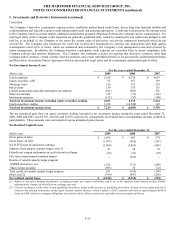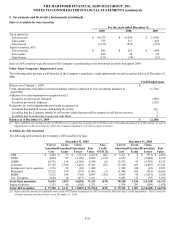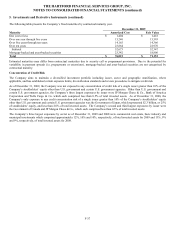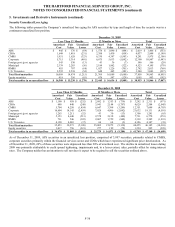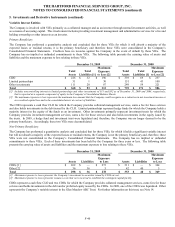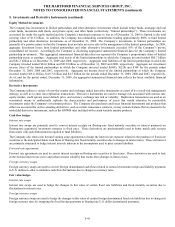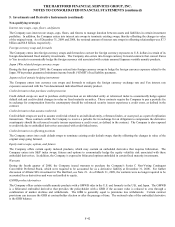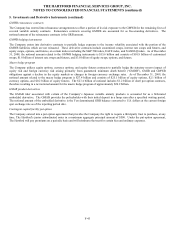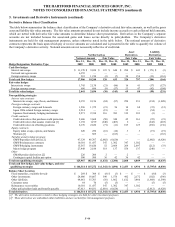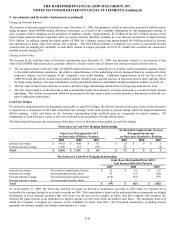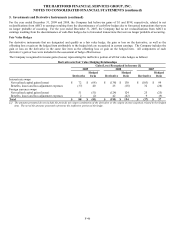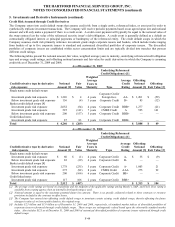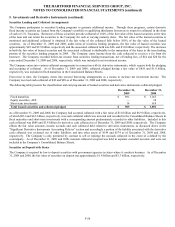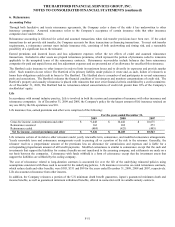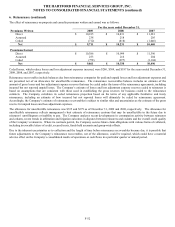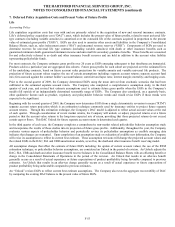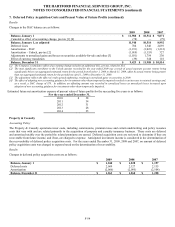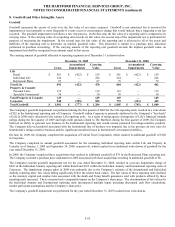The Hartford 2009 Annual Report Download - page 194
Download and view the complete annual report
Please find page 194 of the 2009 The Hartford annual report below. You can navigate through the pages in the report by either clicking on the pages listed below, or by using the keyword search tool below to find specific information within the annual report.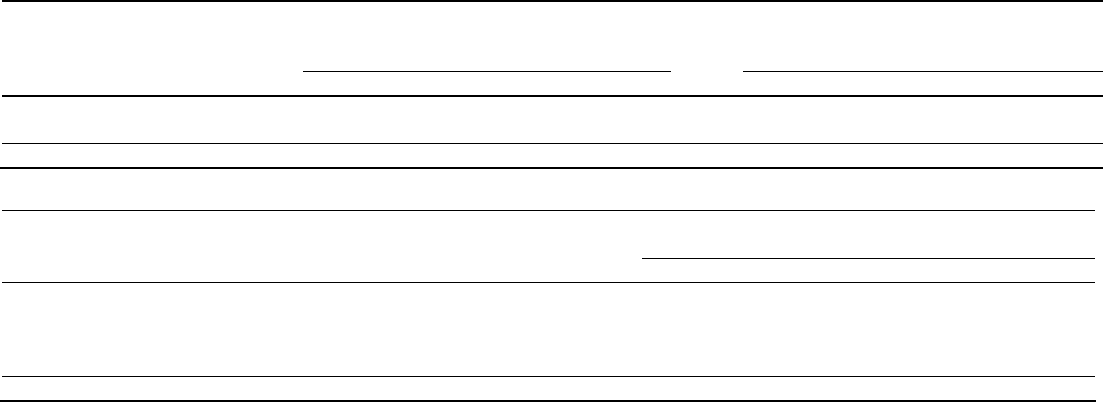
THE HARTFORD FINANCIAL SERVICES GROUP, INC.
NOTES TO CONSOLIDATED FINANCIAL STATEMENTS (continued)
F-45
5. Investments and Derivative Instruments (continued)
Change in Notional Amount
The increase in notional amount of derivatives since December 31, 2008, was primarily related to derivatives associated with the macro
hedge program, while GMWB related derivatives decreased, as a result of the Company rebalancing its risk management strategy to
place a greater relative emphasis on the protection of statutory surplus. Approximately $1.2 billion of the $25.3 billion increase in the
macro hedge notional amount represents short put option contracts therefore resulting in a net increase in notional of approximately
$24.1 billion. In addition, during the fourth quarter of 2009, the Company entered into approximately $6.4 billion notional of forward
rate agreements to hedge short term interest rate exposure. This $6.4 billion notional is comprised of a series of one month forward
contracts that are hedging the variability of cash flows related to coupon payments on $555 of variable rate securities for consecutive
monthly periods during 2010.
Change in Fair Value
The increase in the total fair value of derivative instruments since December 31, 2008, was primarily related to a net increase in fair
value of all GMWB related derivatives, partially offset by a decline in fair value of interest rate derivatives and credit derivatives.
• The net improvement in the fair value of GMWB related derivatives is primarily due to liability model assumption updates related
to favorable policyholder experience, the relative outperformance of the underlying actively managed funds as compared to their
respective indices, and the impacts of the Company’ s own credit standing. Additional improvements in the net fair value of
GMWB related derivatives include lower implied market volatility and a general increase in long-term interest rates, partially offset
by rising equity markets. For more information on the policyholder behavior and liability model assumption updates, see Note 4a.
• The fair value of interest rate derivatives used in cash flow hedge relationships declined due to rising long-term interest rates.
• The fair value related to credit derivatives that economically hedge fixed maturity securities decreased as a result of credit spreads
tightening. This decline was partially offset by an increase in the fair value related to credit derivatives that assume credit risk as a
part of replication transactions.
Cash Flow Hedges
For derivative instruments that are designated and qualify as cash flow hedges, the effective portion of the gain or loss on the derivative
is reported as a component of OCI and reclassified into earnings in the same period or periods during which the hedged transaction
affects earnings. Gains and losses on the derivative representing hedge ineffectiveness are recognized in current earnings. All
components of each derivative’ s gain or loss were included in the assessment of hedge effectiveness.
The following table presents the components of the gain or loss on derivatives that qualify as cash flow hedges:
Derivatives in Cash Flow Hedging Relationships
Gain (Loss) Recognized in OCI
on Derivative (Effective Portion)
Net Realized Capital Gains (Losses)
Recognized in Income
on Derivative (Ineffective Portion)
2009 2008 2007 2009 2008 2007
Interest rate swaps $ (461) $ 908 $ 97 $ (3) $ 9 $ 3
Foreign currency swaps (194) 233 (53) 75 — (2)
Total $ (655) $ 1,141 $ 44 $ 72 $ 9 $ 1
Derivatives in Cash Flow Hedging Relationships
Gain (Loss) Reclassified from AOCI
into Income (Effective Portion)
2009 2008 2007
Interest rate swaps Net realized capital gains (losses) $ 11 $ 34 $ (3)
Interest rate swaps Net investment income (loss) 47 (17) (20)
Foreign currency swaps Net realized capital gains (losses) (119) (83) (79)
Foreign currency swaps Net investment income (loss) 2 1 —
Total $ (59) $ (65) $ (102)
As of December 31, 2009, the before-tax deferred net gains on derivative instruments recorded in AOCI that are expected to be
reclassified to earnings during the next twelve months are $44. This expectation is based on the anticipated interest payments on hedged
investments in fixed maturity securities that will occur over the next twelve months, at which time the Company will recognize the
deferred net gains (losses) as an adjustment to interest income over the term of the investment cash flows. The maximum term over
which the Company is hedging its exposure to the variability of future cash flows (for forecasted transactions, excluding interest
payments on existing variable-rate financial instruments) is 3 years.


